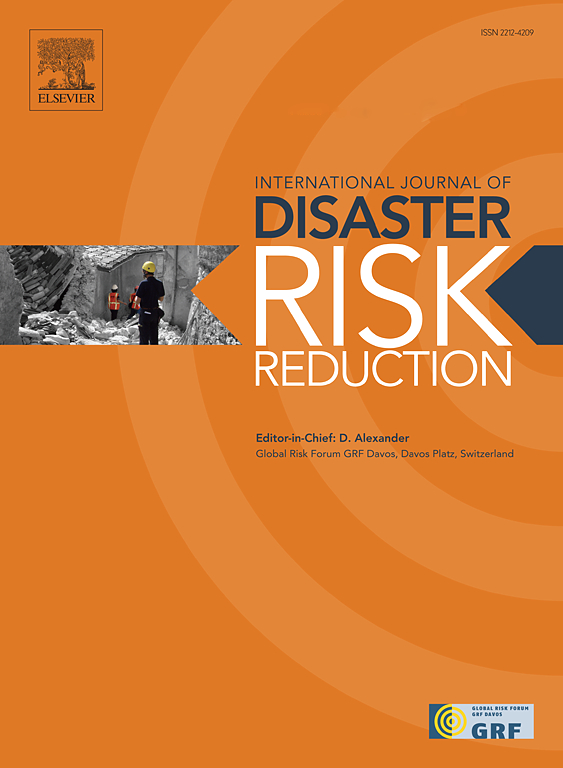探索气候变化事件与移民决策之间的关系:来自孟加拉国选择实验的证据
IF 4.2
1区 地球科学
Q1 GEOSCIENCES, MULTIDISCIPLINARY
International journal of disaster risk reduction
Pub Date : 2024-09-16
DOI:10.1016/j.ijdrr.2024.104831
引用次数: 0
摘要
孟加拉国是一个地势低洼的三角洲国家,极易受到气候灾害的影响。哈提亚岛位于孟加拉国南部,居民主要依靠渔业和农业为生。然而,该岛的初级生产系统面临着强烈而频繁的突发性环境灾害(如河流侵蚀、飓风和洪水)以及缓慢发生的环境灾害(如盐水入侵、潮汐淹没和气温上升)的威胁。人们对突发性和缓发性灾害对哈提亚居民迁移模式的影响知之甚少。本研究旨在调查气候事件与哈提亚岛居民迁移决定之间的关系。为了探究这一关系,我们采用选择实验调查的方法,从哈提亚岛上的 337 名受访者那里收集了经验数据。我们利用五个属性来构建移民情景,包括哈提亚岛的气候事件、移民距离、移民类型、潜在目的地的社会网络以及哈提亚岛与潜在目的地之间的收入差异。混合对数模型的结果表明,哈提亚岛的气候事件、迁移距离和收入差距影响了居民的迁移决策。与中等程度的缓变和骤变相比,极端缓变和极端骤变导致移民的可能性较小。然而,随着 Hatiya 与预期目的地之间收入差距的扩大,居民更有可能迁移。对于极端突发性变化,居民愿意在收入增加 9.4% 的情况下迁移,而对于极端缓慢突发性变化,居民则需要在收入增加 14.19% 的情况下迁移。因此,需要制定政策,通过改善社会保护体系来支持接收地区的移民,支持移民输出家庭在原籍地区的转型适应,并支持哈提亚社区驱动的适应行动。本研究的结果可为有关环境危害与流动性之间关系的现有文献做出贡献,并就如何制定支持弱势群体的政策为政策制定者提供信息。本文章由计算机程序翻译,如有差异,请以英文原文为准。
Exploring the relationship between climate change events and migration decisions: Evidence from a choice experiment in Bangladesh
Bangladesh is a low-lying deltaic nation with high vulnerability to climate-related hazards. Hatiya Island is located in Southern Bangladesh, and residents rely significantly on fishing and agriculture for their livelihoods. However, the island's primary production systems face a threat from intense and frequent sudden onset environmental hazards such as river erosion, cyclones, and flooding, as well as slow onset environmental hazards like saline intrusion, tidal inundation, and rising temperatures. Little is known about the effect sudden onset and slow onset hazards have on the migration patterns of Hatiya's residents. The aim of this study is to investigate the relationship between climatic events and the migration decisions of residents on Hatiya Island. To explore this link, we collected empirical data from 337 respondents on Hatiya Island using a choice experiment survey. The five attributes were used to construct migration scenarios, including climate events at Hatiya Island, the distance of migration, the migration type, the social network at the potential destination, and the difference in income between Hatiya Island and the potential destination. The findings from the mixed logit model indicated that climate events at Hatiya, migration distance, and income gap affected residents' migration decisions. Extreme slow onset change and extreme sudden onset change were less likely to induce migration compared to the moderate level of slow and sudden onset change. However, residents were more likely to migrate as the income difference between Hatiya and the prospective destination increased. Residents were willing to migrate at a 9.4 % increase in income for extreme sudden onset change, while residents required a 14.19 % increase in income to migrate in response to extreme slow onset change. As such, policies are needed to support migrants in receiving areas through improved social protection systems, to support migrant-sending households' transformative adaptation in origin areas, and to bolster community-driven adaptation initiatives in Hatiya. The findings from this study can contribute to the existing literature on the relationship between environmental hazards and mobility and inform policymakers on how to design policies that support vulnerable populations.
求助全文
通过发布文献求助,成功后即可免费获取论文全文。
去求助
来源期刊

International journal of disaster risk reduction
GEOSCIENCES, MULTIDISCIPLINARYMETEOROLOGY-METEOROLOGY & ATMOSPHERIC SCIENCES
CiteScore
8.70
自引率
18.00%
发文量
688
审稿时长
79 days
期刊介绍:
The International Journal of Disaster Risk Reduction (IJDRR) is the journal for researchers, policymakers and practitioners across diverse disciplines: earth sciences and their implications; environmental sciences; engineering; urban studies; geography; and the social sciences. IJDRR publishes fundamental and applied research, critical reviews, policy papers and case studies with a particular focus on multi-disciplinary research that aims to reduce the impact of natural, technological, social and intentional disasters. IJDRR stimulates exchange of ideas and knowledge transfer on disaster research, mitigation, adaptation, prevention and risk reduction at all geographical scales: local, national and international.
Key topics:-
-multifaceted disaster and cascading disasters
-the development of disaster risk reduction strategies and techniques
-discussion and development of effective warning and educational systems for risk management at all levels
-disasters associated with climate change
-vulnerability analysis and vulnerability trends
-emerging risks
-resilience against disasters.
The journal particularly encourages papers that approach risk from a multi-disciplinary perspective.
 求助内容:
求助内容: 应助结果提醒方式:
应助结果提醒方式:


